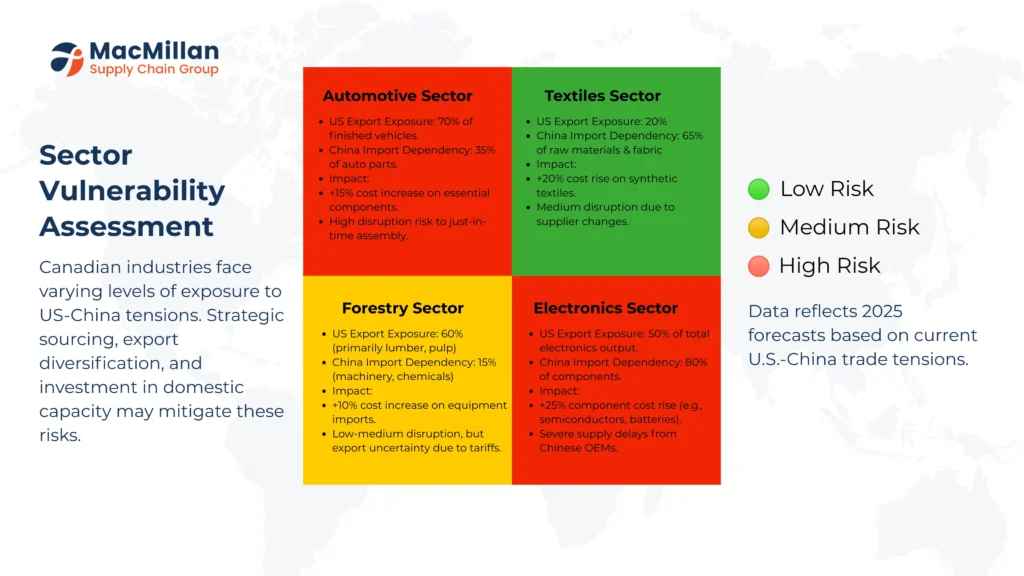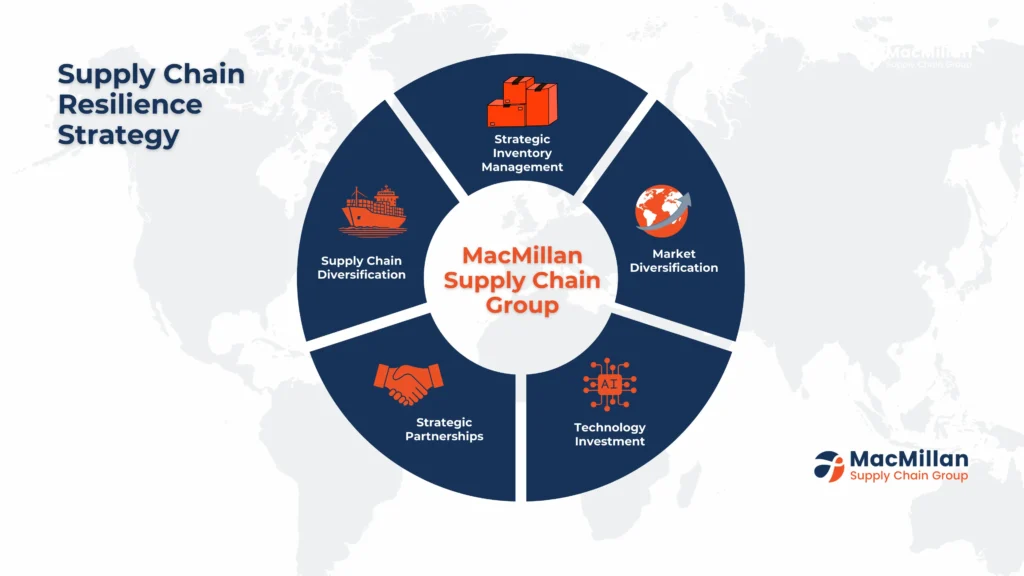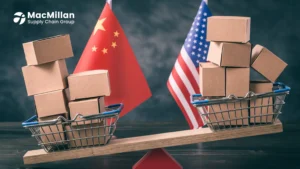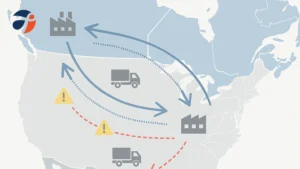With tariffs on Chinese imports to the US rising to 125% in, the US-China trade war 2025 has escalated to unprecedented levels. Canadian companies are caught in the crossfire even though the country isn’t specifically targeted. For businesses that depend on cross-border trade, this economic conflict threatens market access, raises costs, and disrupts supply chains.
While larger businesses struggle with operational disruptions, small retailers who source from China and sell to the US face immediate challenges. Important industries like forestry, textiles, and electronics are especially at risk. This article examines how the trade war has affected Canadian supply chains and provides useful advice for companies looking to weather these choppy waters.
Caught in the Crossfire: What the US-China Trade War 2025 Means for Canadian Supply Chains
In 2025, the US-China trade war has escalated significantly, sending shockwaves well beyond the boundaries of these two economic superpowers. Despite not being the direct targets, Canadian companies are suffering severe collateral damage as a result of the United States’ imposing tariffs of up to 125% on Chinese goods. Supply chains that Canadian businesses have depended on for decades are being disrupted by this economic conflict, which is also changing patterns of international trade.
The impact is getting harder to ignore for companies all over Canada, from manufacturing behemoths in Ontario to tiny retailers in British Columbia. As the ripple effects spread throughout interconnected global markets, even businesses without direct ties to China are impacted. Canadian supply chains face previously unheard-of difficulties as tariffs raise prices and cause uncertainty, necessitating innovative solutions and strategic adaptation.
Let’s explore how this trade war is affecting Canadian businesses, which sectors are most vulnerable, and what strategies companies can implement to protect themselves in this volatile environment.
Understanding the US-China Trade War 2025: A Perfect Storm
It took time for the US and China to develop the current trade tensions. They are the result of years of conflicting global aspirations, political disagreements, and economic rivalry. International trade relations are in a perfect storm in 2025 due to a number of factors.
Targeting Chinese imports, the US has imposed a multi-tiered tariff system, with duties on some goods reaching 125%. Raw materials and completed goods, as well as textiles and electronics, are all impacted by these tariffs. Reducing the US trade deficit, preserving American jobs, and resolving national security issues pertaining to vital supply chains and technologies are among the stated objectives.
China has retaliated with its own countermeasures, such as import restrictions and tariffs on American goods. For businesses around the world, long-term planning is very challenging due to the climate of uncertainty created by this tit-for-tat escalation.
Because of our special position, the situation is especially difficult for Canadian businesses. With China as our second-largest trading partner and the United States as our largest, Canada maintains close economic ties with both nations. Canadian companies are frequently caught in the middle of these titans’ conflicts, with disruptions coming from both sides.
Another level of complexity is introduced by the unpredictable nature of policy changes. Businesses are frequently given little notice when new tariffs or trade restrictions are announced, leaving them with little time to adjust. Instead of adhering to meticulously crafted strategic plans, this volatility compels businesses to function in a reactive manner.
Canada Supply Chain Impact,Who’s Suffering
The ways that the US-China trade war 2025 has affected Canadian supply chains differ greatly depending on the kind of business and industry. It is essential to comprehend these effects in order to create efficient response plans.
Small and Medium-Sized Businesses
Small manufacturers and retailers are especially at risk. They are directly in the crossfire since many import goods or materials from China and resell them in the US market. For instance, a clothing company based in Vancouver that imports fabrics from China and exports completed clothing to the US now has to deal with increased expenses at both ends of their supply chain. Uncertainty and growing expenses have caused some small businesses to halt up to 80% of their Chinese orders.
Usually, these smaller businesses don’t have the resources to switch suppliers or markets quickly. They frequently have smaller profit margins, which limits their ability to absorb rising expenses without raising consumer prices.
Larger Enterprises
There are many obstacles to overcome, even for big Canadian companies with more resources. Businesses that rely heavily on US sales, such as Lululemon, have seen a drop in stock values as investors fear the effects of the trade war. Large manufacturers and retailers have to manage intricate supply chain interruptions while keeping prices competitive.
Larger companies frequently have more intricate supply chains with numerous touchpoints in both China and the US, even though they might be more adaptable. Even though they have a lot of resources at their disposal, restructuring these established networks takes a lot of time and money.

Sectors Most Affected by US China Tariffs 2025
Different industries are affected by the trade war in very different ways, with some experiencing more serious disruptions than others.
Technology and Electronics
The electronics sector has been particularly severely impacted. Businesses deal with increased component costs and production delays as a result of intricate global supply chains that are frequently based on Chinese manufacturing. Computers, gaming consoles, and smartphones are becoming more expensive for Canadian consumers. Due to supply constraints and manufacturers’ preference for larger markets, some technology releases have been postponed in the Canadian market.
Textiles and Apparel
Given that textile production has been largely concentrated in China for decades, clothing manufacturers and retailers face numerous obstacles. Relocating production to other countries, such as Bangladesh, India, or Vietnam, necessitates forging new connections, maintaining quality control, and negotiating various regulatory frameworks, all of which take time and temporarily raise costs.
Rural Materials and Forestry
Trade disruptions put additional strain on Canada’s forestry industry, which is already coping with issues like pine beetle infestations and shifting environmental regulations. Economic strain is being felt by communities in British Columbia and other areas that depend on forestry as export markets become less dependable and more costly to serve.
Automotive and Manufacturing
Particular difficulties are faced by the automotive sector because of its highly integrated North American supply chains. During production, parts and components frequently travel across borders several times, possibly resulting in tariffs at each stop. Because of its complexity, the industry is particularly susceptible to disruptions in major economies’ trade.
Economic Ripple Impacts Outside of Direct Trade
Beyond direct import and export ties, the US-China trade war 2025 has wider economic ramifications that affect almost all Canadian consumers and businesses.
Consumer Price Increases
Many companies are forced to pass on the higher costs of imported materials and goods to customers. Prices for electronics, apparel, furniture, and many other items have increased for Canadians. These price increases impact everyone’s purchasing power by adding to the economy’s overall inflationary pressures.
Supply Chain Disruptions and Shortages
Many businesses have canceled or delayed orders as a result of the trade war’s uncertainty, which has affected supply chains. Product shortages have surfaced in a number of industries, including building materials and electronics. Both consumers and businesses experience delays and price increases as a result of these shortages.
Investment Hesitancy and Market Uncertainty
The unpredictable nature of trade tensions has made many businesses hesitant to make major investments. Everything from new product development to facility expansions is impacted by this prudence. As businesses choose to “wait and see” instead of pursuing aggressive expansion plans, economic growth may slow.
Potential Recession Risks
Given our close economic ties, some economists caution that ongoing trade tensions could lead to a recession in the US, which would unavoidably affect Canada. A downturn in the US economy would lower demand for Canadian exports in all industries, which could lead to a slowdown in the Canadian economy as a whole.
Trade War Difficulties for Canadian Companies
As they negotiate the complicated environment brought about by the US-China trade war 2025, Canadian businesses encounter several challenges:
Disruption of the Supply Chain
Long-standing supply chains that took years to establish are now in a state of chaos. As suppliers deal with tariffs and trade restrictions of their own, businesses find it difficult to maintain consistent access to materials and components.
Price Increases
While supply shortages cause prices to rise through market forces, tariffs directly raise the cost of imported goods. These increased expenses put pressure on profit margins and necessitate tough choices regarding pricing policies.
Uncertainty in Market Access
Future market access is uncertain for Canadian companies that export to the US or China. Rapid strategic adjustments may be necessary if policy changes abruptly reduce the accessibility or profitability of particular markets.
Disadvantages of Competition
In some markets, businesses in nations with preferential trade agreements may have an advantage over Canadian companies. This dynamic competitive environment necessitates ongoing observation and adjustment.
Planning Challenges
Because trade tensions are unpredictable, long-term planning is very difficult. Instead of sticking to a single, well-defined plan, businesses need to create several backup plans.
Fewer Options
In the short term, it may be difficult or impossible to find substitute suppliers for many specialized parts or materials outside of China. It takes a lot of time and money to develop new supply sources.

Strategic Responses to Trade War Challenges
Despite these significant obstacles, Canadian companies can use a number of tactics to reduce risks and stay competitive in this unstable market:
Diversification of the Supply Chain
Diversifying supply chains is one of the best ways to lessen reliance on any one nation. This strategy could consist of:
- Investigating alternate sourcing sites in Southeast Asia (Malaysia, Thailand, and Vietnam) or other areas where the current tariffs have less of an impact
- Building ties with several suppliers in various nations to establish redundancy
- Examining possibilities for nearshoring in Mexico or moving some production to Canada
- Developing supply chains that are modular so they can quickly adjust to shifting market conditions
For example, a Canadian electronics manufacturer previously reliant on Chinese components might develop parallel supply chains in Vietnam and Mexico, allowing them to shift production based on changing tariff structures.
Strategic Inventory Management
Changing inventory management techniques can help protect against interruptions in the supply chain:
Increasing safety stock levels for essential parts sourced from high-risk areas; optimizing stock levels through the use of more advanced inventory tracking systems; and creating backup plans in case of supply disruptions
In order to account for possible delays, flexible delivery schedules are negotiated with clients
For instance, a furniture retailer might increase the number of popular Chinese-made items in their inventory while simultaneously developing relationships with overseas producers in anticipation of future orders.
Market Diversification
Canadian companies can protect themselves from the effects of the trade war by reducing their reliance on the US market:
- Investigating prospects within the European Union while utilizing the CETA trade agreement
- Creating plans for the UK market under the Canada-UK Trade Continuity Agreement – Entering new markets in Southeast Asia, Africa, or Latin America
Increasing market share in Canada’s home market
In order to create a more balanced customer portfolio, a Canadian food processor that exports mostly to the US might create new product lines especially tailored for European tastes and regulations.
Investment in Supply Chain Technology
Cutting-edge technologies can increase agility and visibility:
- Putting in place supply chain management software that offers real-time visibility and using predictive analytics to foresee possible interruptions
- Using blockchain technology to increase transparency and traceability – Using artificial intelligence to forecast demand more precisely
Businesses can react to changes faster and make better decisions in unpredictable situations with the aid of these technological solutions.
Collaboration and Strategic Alliances
Working together with other organizations can benefit both parties:
- Creating alliances with related companies to boost purchasing power
- Working together with trade groups to promote policy modifications
- Building stronger ties with important clients and suppliers to enhance information exchange – Investigating joint ventures that pool resources and risks
Canadian companies can create more robust supply chain solutions and realize economies of scale by collaborating instead of working alone.
Taking Action: Practical Steps for Canadian Businesses
Here are specific actions you can take immediately if you’re a Canadian manager or business owner worried about how the US-China trade war 2025 will affect your supply chain:
- Perform a vulnerability assessment: Examine your supply chain to find areas where US-China trade tensions could affect you. To identify possible risk areas, map out the sources of your inputs and the destinations of your products.
- Create contingency plans: Make detailed plans of action for various situations, like further tariff hikes or export limitations. Having these plans in place enables a quicker reaction to unforeseen circumstances.
- Involve with industry associations: Make contact with the trade associations in your industry to learn about advocacy initiatives and policy changes. These groups frequently possess data and resources that private companies might not be able to obtain on their own.
- Speak with supply chain experts: Take into account collaborating with experts who are knowledgeable about the complexities of global trade and who can offer customized guidance for your particular circumstance.
- Discover government assistance programs: To assist companies in adjusting to trade obstacles, the federal and provincial governments provide a range of programs. These could include advisory services, financing options, or aid for export development.
We at MacMillan Supply Chain Group are aware of the particular difficulties that Canadian companies encounter in the current unstable trade climate. Our team of supply chain specialists specializes in assisting businesses in creating flexible, robust logistics solutions that can endure disruptions in international trade.
We provide alternative sourcing methods, thorough supply chain analyses, and tailored logistics solutions made especially for the Canadian market. Despite the difficulties associated with international trade, our vast warehouse network throughout the Greater Toronto Area offers a variety of flexible storage options, and our cutting-edge distribution capabilities guarantee that your products reach customers effectively.
Avoid letting the trade war between the US and China stop the expansion of your company. To find out how we can assist you in navigating these difficult times and turning possible disruptions into competitive advantages, get in touch with MacMillan Supply Chain Group right now.
FAQS
Even if your business doesn't import directly from China or export to the US, you're likely still affected through your supply chain. Many Canadian suppliers source materials or components from China, meaning their costs increase with tariffs. Additionally, global market disruptions affect pricing across industries. For example, if electronics manufacturers face higher costs for Chinese components, prices may rise for all electronics, regardless of origin.
The most vulnerable sectors include electronics, textiles and apparel, furniture manufacturing, and certain raw materials. Industries with complex global supply chains or those heavily dependent on Chinese manufacturing are particularly at risk. The automotive sector also faces significant challenges due to its integrated North American supply chain and the complexity of component sourcing.
Economic analysts suggest the trade tensions may persist for several years, as they stem from fundamental strategic competition between the two powers rather than simple trade disagreements. Businesses should prepare for long-term adaptation rather than expecting a quick resolution. Most experts recommend developing strategies that assume trade tensions will continue through at least 2026-2027.
Many Canadian companies are exploring Vietnam, Thailand, Malaysia, and India as alternatives to China for manufacturing and sourcing. Mexico is also gaining attention for nearshoring opportunities due to its proximity and CUSMA (formerly NAFTA) benefits. Each alternative location has its own advantages and challenges regarding infrastructure, labor costs, expertise, and existing trade agreements.
The trade war has disrupted traditional shipping routes and created new patterns as companies adjust their sourcing strategies. This has led to capacity constraints in some regions, longer lead times, and increased shipping costs. Additionally, companies often need to develop new logistics partnerships when shifting to alternative sourcing countries, adding complexity to supply chain management.
The Canadian government offers various support mechanisms, including Export Development Canada (EDC) financing, Trade Commissioner Service advisory support, and regional economic development programs. Some provinces also provide specific assistance for businesses adapting to trade challenges. The Canada Tariff Finder tool helps businesses navigate complex tariff structures when exploring new markets.
Small businesses can focus on strategies that require less capital investment, such as joining purchasing consortiums, exploring dropshipping models that reduce inventory requirements, or partnering with larger companies. Industry associations often provide resources specifically for small businesses, including group purchasing opportunities and shared market intelligence.
Some Canadian manufacturers have found new opportunities as US buyers look for alternatives to Chinese suppliers. Companies that can position themselves as reliable, tariff-free alternatives may gain market share. Additionally, some Canadian service providers specializing in supply chain consulting, trade compliance, or logistics have seen increased demand as businesses seek expertise in navigating the complex trade environment.
While US businesses face direct impacts from tariffs on Chinese goods, Canadian companies experience more indirect effects. Canadian businesses must navigate a complex situation where both major trading partners are engaged in conflict. However, Canadian companies sometimes have advantages in accessing Chinese markets compared to US competitors, as Canada isn't directly involved in the trade dispute.
The most valuable technologies include supply chain visibility platforms that provide real-time tracking of shipments and inventory, predictive analytics tools that help forecast potential disruptions, and supplier management systems that facilitate communication with diverse supplier networks. For smaller businesses, even basic improvements in inventory management software can significantly improve adaptability to changing trade conditions.




